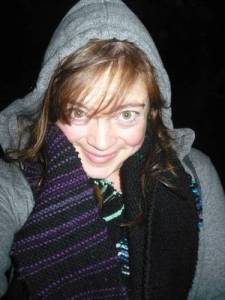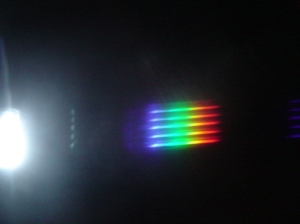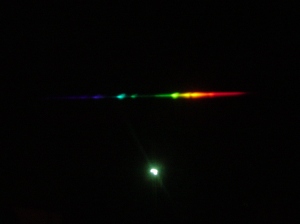
2.2 SQ Podcast Episode 4 – Quilting the Spectrum
December 6, 2009
Many days in science class I stared at the emission spectra posters on the wall. Which may explain why I am drawn to the black, white and rainbow colored pattern I bought from a local quilt artist, Linda Everhart at Quilting Among Friends and the quilt on the wall at the local quilt show this past summer.

It was no surprise that when I saw the Science Craftster Swap from March that I immediately stopped to look at the spectra scarf made by echo_brook to give to pocketwatch. Sending a message to Echo_brook, she plans to knit a blanket of the same design. Here is pocketwatch’s scarf found on page 10 (not 15) on her cool art couch.

And here is pocketwatch showing off the purple portion of the knitted scarf. Why is the design that way with “random” purple and black (and other colors)? It’s not random, it’s an emission spectra of Argon. Perfect for the length of a scarf!

The emission spectra is something explored in physics and astronomy.
A tool that breaks up light is a prism, and a tool that has many “microprisms” on a thin sheet is a diffraction grating. Prisms and diffraction gratings break up light by bending the light that travels at different speeds. You may see “rainbow glasses” at your favorite science museum or science gift shop – that’s probably a diffraction grating that you’re buying. Below is a picture of the diffraction grating.

A CD also can serve as a ‘makeshift’ diffraction grating.
For a summer I did research on the hydrogen spectra at Kansas State Physics Education Research Group. It was the first time I saw a video camera with a diffraction grating taped to the side of it. We set up our hydrogen gas tube, turned off the lights and took some pictures. Of spectra.

What is spectra? Spectra is a visible amount of energy due to moving electrons in an atom. We put energy into the hydrogen atom by adding electricity, and then the electron moves away from home for a while. Then the electron gets bored and comes back, but it doesn’t get to keep that fancy energy. So it emits energy, some of which, is in the form of light – visible light. And if we have the right tools to break up the light, we can get a specific pattern of colors, which we call a spectra. Each element has a unique emission spectra due to the number of electrons and where they are located in the atom … and a bunch of other reasons.
If you want to see a periodic table that shows each specific element’s emission spectra in gif form, click here to go to the Penn State Erie site (click on each element to get to the spectra picture). A periodic table with the symbols and element names is necessary to get the correct element here (unless you were forced to memorize the first 4 rows like I was – even several years after teaching I could remember most of them). Feel free to search for “emission spectra” or “emission spectrum” in google for more info.

This one is Argon. I downloaded it from the website to use for my quilt design.
Scientists will use a device called a spectroscope (dark box with a long thin slit and a “ruler” inside to measure the distance of the colors) to determine the elements that make up various gases. For a tutorial on how to make a CD spectroscope, and a spectroscope with a cereal box and a diffraction grating, click here.
In the meantime …
Placing the diffraction grating in front of my camera lens produces interesting effects.
Using a diffraction grating on my ceiling light fixture shows bulbs of color, which demonstrates that the light source is where the rainbow is coming from.

And this following picture was of a set of 6 LEDs in a row which I liked.

Braving the December evenings I stepped outside to take a picture of the street light with the diffraction grating in front.

Turning to the side slightly about 20 – 30 degrees, you can see the spectra through the diffraction grating. Notice the lonely cyan light, in addition to the bright green and yellow lights.

The diffraction grating had only about 1000 lines / mm. More lines would give a higher resolution, but are also (slightly) more expensive. Also the diffraction grating was a little dirty and I tried to clean it as best as I could. Sodium has a distinct “double yellow” line(s) that would be easier to see with a more precise diffraction grating. I am still betting this street lamp is sodium rather than mercury due to the brightness of the yellow here.
How can this relate to quilting?
What about a special scientific quilting design that is pleasing to the eye but also has a “hidden scientific code” inside?

I call this “coin quilt” design “Noble Metallic Spectra” (Chlorine isn’t noble gas, nor metallic, but I like the name anyway). The symbol names in red at the bottom could be stitched as embroidery or quilting on the quilt itself.
As mentioned in the podcast you could do this as a coin quilt and consolidate the blacks (and maybe some of the colored bars) together, or you could do bias bars as the colored strips appliqued on top.
Letting my imagination run away from me, I produced a ring quilt using the polar coordinate filter on Photoshop.

This one I call “Medals of Elements” because its Copper, Silver, and Gold and traditionally medals are given as copper, silver, and gold (and they were my favorite crayon colors growing up).
Maybe I should draw up a “pattern” for these and become a scientific pattern designer? Well first I have to create the quilts to know if they will actually work.
Additional resources
- A periodic table poster from Amazon
- A spectra poster from Edmund Scientific
Bleach dyes websites from Deb
- Bleach King Tutorial from someone who spent a lot of time researching bleaching fabric.
- Leaf designs from an art quilter.
- Botanically Correct design using leaves as a background design from HGTV.
Websites to check out of other quilting podcasts mentioned in the show
- Kelly at The Pioneer Quilter and comment on the Generations post
- Ruthann at Mirkwood Designs
- Jennifer at Patchwork and Pacifiers
- Jean at Quilted Cupcake
- Brye at Sew Stitch Create
- Leah at 365 Free Motion Filler Designs (not a podcast, but blog)
- Annie Smith Quilting Stash
- Allison at Within a Quarter Inch
Thanks also to my commenters
- Janetsnina, IamSusie, Deb, Kelley, Ruthann, Lauretta6, Janet
Feel free to let me know about your scientific adventures in quilting or other crafts!
Keep experimenting!
EDIT: I created an item with an embroidered spectra – a Sewing Machine Cover. Find the link here!
[…] I have already designed a quilt that looks very similar to this – the Spectra Quilt idea. […]
I’ve just recently discovered your podcast and I love it! I listened to this colour spectrum episode tonight (while I was cutting fabric for a Bento Box quilt) and am so inspired. I quickly went to my computer to read your show notes and now I really want to make a spectrum quilt. Just add it to my giant list of quilts I want to make some day… 🙂
I’m a computer scientist (my degree is in mathematics) so I really appreciate a sciency/left-brain quilting podcast. Thanks!
Jen, haven’t gotten back to you recently. Sorry. Glad to know about your bento box quilt – I love those – and I am so glad you’re excited about the spectrum quilt idea. I can’t wait to finish mine now. Got a little bit started on it already (finally).
[…] measure for the 4 year old spectrum quilt idea […]